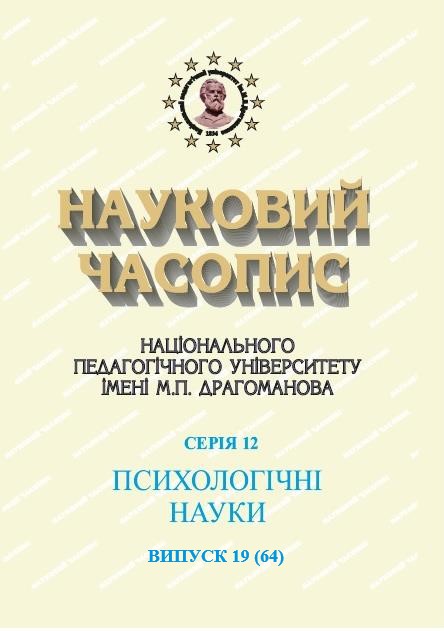THE CLIENT’S EXISTENTIAL SITUATION AS A FOUNDATION IN THE CONDUCT OF PSYCHOSYNTHESIS
DOI:
https://doi.org/10.31392/NPU-nc.series12.2022.19(64).05Keywords:
existential situation, personal psychosynthesis, spiritual psychosynthesis, disidentification, conscious self, Higher Self, duality.Abstract
The article carries out a theoretical and methodological study of the problem of the client’s existential situation in the practice of psychosynthesis. It was established that the client’s existential situation is presented in psychosynthesis as a process of structuring their life experience as a result of subject-oriented psychotherapeutic cooperation. According to eleven criteria, the authors propose content components of the existential situation, which are revealed and changed in the process of psychotherapy. It is emphasized that the beginning of psychosynthesis is based on the client’s orientation to their conscious self, the existence of which appears due to disidentification with any content of consciousness. Special importance is attached to the synthetic function of the conscious self as a projection of the Higher Self. The problem of the client’s spiritual requests in general and self-realization in particular is described by the concept of the Higher Self. It is noted that in the practice of psychosynthesis, the work of a specialist requires systematic self-psychosynthesis. The psychological meaning of the phenomenon of duality has been specified as the main subjective factor that blocks the cooperation of both the participants in psychotherapy. Instead, the specialist is encouraged to develop a non-dual attitude as a primarily personal, not just a professional, quality. It has been established that the special methodology of psychosynthesis is represented by its four stages that correspond to the tasks of psychotherapy. Changing the client’s existential situations is presented in the client’s mind as an opportunity to change one’s own personality, which is based on disidentification and involves two levels of psychosynthesis, that is personal and spiritual ones. Spiritual psychosynthesis is conducted on the basis of studying the client’s spiritual experiences, taking into account the crisis stages of their spiritual development and only after he has achieved personal psychosynthesis. It has been established that in the specific methodology of both levels of psychosynthesis, the psychotherapist should rely on the choice of the most appropriate techniques and methods, taking into account the client’s actual requests. This choice is organically included in the existential situation of direct work with the client “here and now”.
References
- Kucherenko, (2018). Psykhosyntez: teoriia i praktyka psykhoterapii : navchalno-metodychnyi posibnyk [Psychosynthesis: the theory and practice of Psychotherapy]. Vinnytsia : TOV «TVORY» [in Ukrainian].
- Maksymenko, K. (2015). Sopostavitelnyj analiz lichnostno-orientirovannyh psihoterapevticheskih podhodov [The comparative analysis of personality-oriented psychotherapeutic approaches]. Problemy suchasnoi psykholohii – The Problems of Modern Prychology, 29, 397–409 [in Russian].
- Maslou, A. (1999). Novye rubezhi chelovecheskoj prirody [The Farthest Reaches of Human Nature]. ( Ball & A. Popogrebskyi, Trans.). Moscow : Eksmo. Retrieved from http://psylib.org.ua/books/masla03/txt11.htm [in Russian].
- Shapar,B. (Ed.). (2009). Psykholohichnyi tlumachnyi slovnyk naisuchasnishykh terminiv [Psychological explanatory dictionary of the most modern terms]. Kharkiv : Prapor [in Ukrainian].
- A Conversation about Subpersonalities with Assagioli (2020). ( Symons, Trans.). Retrieved from https://kennethsorensen.dk/en/a-conversation-about-subpersonalities-with-assagioli
- Assagioli, (1974). Psychosynthesis. A Manual of Principles and Techniques (A Collection of Basic Writings) (An Esalen Book). New York : Viking Compass Edition.
- Assagioli, (2021). Psychosynthesis and Parapsychology. In K. Sørenthen (Ed.). Kentaur Publishing.
- Assagioli, R. (2022). A collection of articles. In K. Sørenthen (Ed.). Kentaur Publishing.
- Dialogue with Assagioli, by Marta Crampton. (2018). Retrieved from https://kennethsorensen.dk/en/dialogue-with-assagioli
- Freud, , & Jung, C.G. (1975). Correspondance. (T. 1, 1906–1909), Traduit par R. Fivaz-Silbermann. Paris : NRF Gallimard.
- Problems are not solved they are forgotten, by Piero Ferrucci and Diana Whitmore. (2020). Retrieved from https://kennethsorensen.dk/en/problems-are-not-solved-they-are-forgotten
- Psychosynthesis training with Assagioli. (2020). (G. Symons, Trans.). Retrieved from https://kennethsorensen.dk/en/psychosynthesis-training-with-assagioli
- Sørenthen, K. (2019). The Seven Types: Psychosynthesis Typology; Discover Your Five Dominant Types. Kentaur Publishing.
- The Rebirth of the Soul, interview with Roberto Assagioli, by Stuart Miller, August 1973. (2017). Retrieved from https://kennethsorensen.dk/en/the-rebirth-of-the-soul-interview-with-roberto-assagioli

